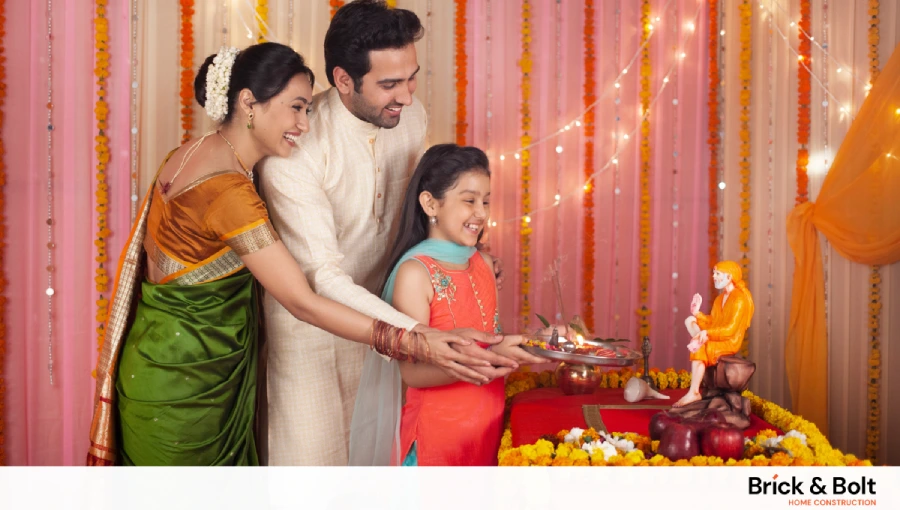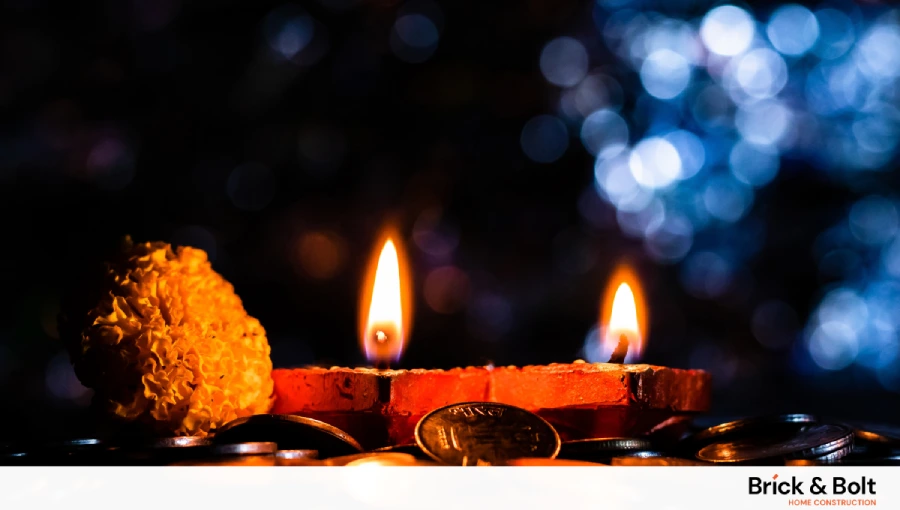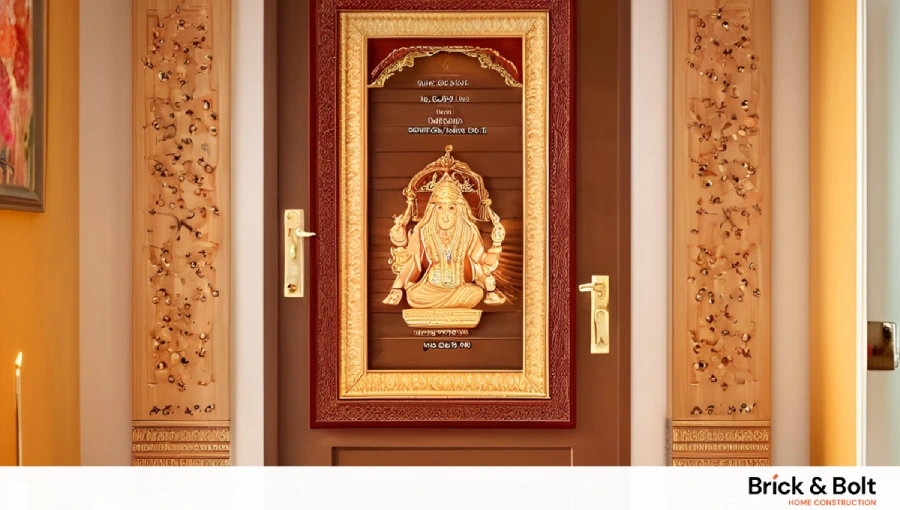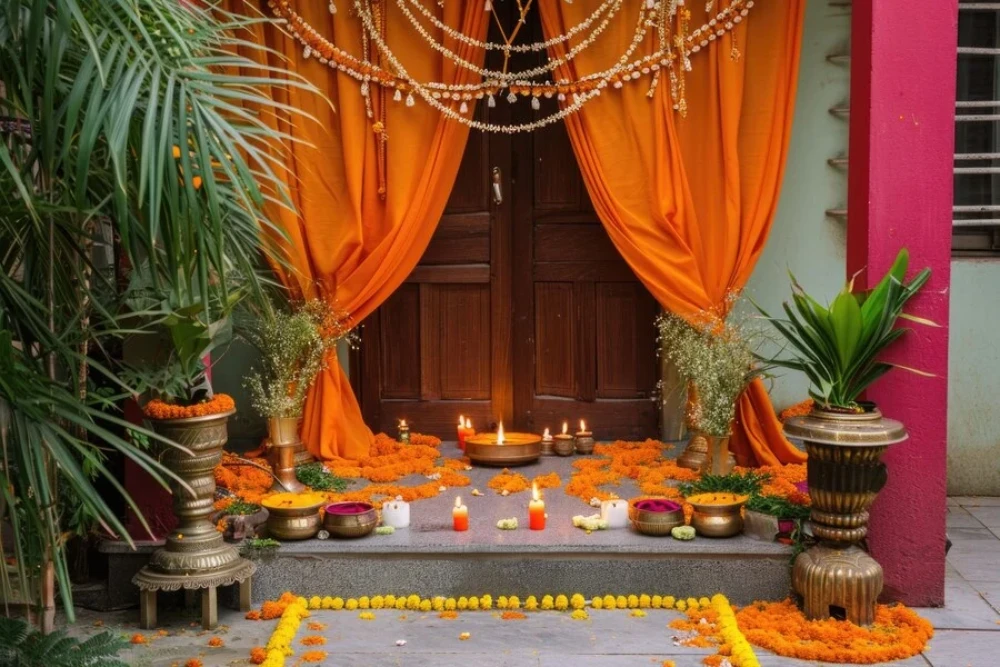A pooja room is highly important in Indian culture. Most people need to create a sacred place in their homes for meditation and prayer.
Vastu Shastra, an ancient science of design and architecture, has emphasized the layout and dimensions of a pooja room that can help optimize the positive energy flow within your home.
By following these Vastu Shastra principles you can really create an uplifting and harmonious place for spiritual reflection.
- 1 Ideal Pooja Room Size
- 2 Why is this Size Considered Ideal?
- 3 Key Points for Your Vastu Pooja Room
- 3.1 Pooja Room Direction As per Vastu
- 3.2 Pooja Room Design As per Vastu
- 3.3 Idol Placement As per Vastu
- 3.4 Vastu for Pooja Room Storage
- 3.5 Vastu for Pooja Room Colour Palette
- 3.6 Importance of Lighting in Pooja Room Vastu
- 3.7 Vastu for Pooja Room Doors
- 3.8 Vastu for Accessories for Pooja Room
- 3.9 Best Areas to Keep Your Pooja Rooms in
- 4 Essential Pooja Room Design Principles
- 5 Conclusion
Ideal Pooja Room Size
Minimum Size For a Pooja Room
According to Vaastu, the minimum size of a pooja room is typically 5 ft x 7 ft.
Why is this Size Considered Ideal?
A minimum pooja room size of 5 feet x 7 feet is considered ideal. Creating a harmonious pooja room requires balancing functionality and design.
This size room provides a comfortable movement for a single person or a small group during daily rituals and keeps a sacred ambiance.
This balance gives an overall flow of positive energy and proportion for your living area.
Key Points for Your Vastu Pooja Room

Some key points that must be considered for setting up a pooja room, according to Vastu, in your home are listed below.
Pooja Room Direction As per Vastu
The direction of the pooja room is ideally located in the northeast corner of your home. That is to get more positive energy and sunlight. Other directions, like east and north, are also considered auspicious.
Pooja Room Design As per Vastu
As per Vastu, a low ceiling is recommended. Also, it can have a pyramid-shaped or gopura-like top to produce a positive environment. If possible, it is recommended to add a threshold and two door entry.
Idol Placement As per Vastu
Idols must be placed a few inches away from the walls and a minimum of six inches from the ground. Ensure that the idols are placed directly above the storage.
Also, avoid placing portraits of the dead and paintings that depict violence in the pooja room. Common idols can be placed in the northeastern corner of the pooja room, and they must not be facing each other.
Vastu for Pooja Room Storage
The puja items must be arranged and placed neatly in cabinets or shelves to avoid clutter. Pooja-related items, lamps, and religious books can be stored pointing southeast. Do not store anything above the idols.
Vastu for Pooja Room Colour Palette
To maintain a serene atmosphere, go for colors like white, light blue, or pale yellow. Specifically, for walls, you can use white, light yellow, or light blue shades. For marble works, select white or light yellow, as they are considered more auspicious for pooja rooms.
Importance of Lighting in Pooja Room Vastu

Lightning is very important in a pooja room. So be sure to have proper light in the room and place the lampstand on the southeast or eastern side. Maintaining proper light can produce an illuminating atmosphere that increases the spiritual experience.
Vastu for Pooja Room Doors

The most preferred doors for pooja rooms are wooden doors with two shutters opening outwards. Pooja rooms can also have northern or eastern walls along with doors and windows. According to Hindu mythology, gods tend to take human form, so they need privacy, so the addition of doors became essential.
Vastu for Accessories for Pooja Room
Try to keep the accessories to a minimum. Focus on key accessories like lamps, incense holders, and offering plates. Metal accessories can be used mainly in brass. It is also good to place a copper vessel filled with water in the pooja room, as it can absorb negative energies.
Best Areas to Keep Your Pooja Rooms in
The best areas to place the pooja rooms are living rooms and kitchens. To maintain their sanctity, they must be located in a quiet and isolated part of the house. Pooja rooms can also be placed in the northeastern part of your kitchen or bedroom.
They must be placed in a good lightning and airflow area as they can have good regulation of energy.
Essential Pooja Room Design Principles
The design of your home’s pooja room is personal and also spiritual. So, it must be simple and uncluttered, as it promotes a peaceful atmosphere.
Some of the essential principles that need to be considered for creating a sacred place are:
- Purpose and spirituality
- Simple and free of clutter
- Vastu Compliance
- Usage of Natural materials and crafts
- Proper lighting and tidy space for storage
- Accessories and privacy
- With personal touch
Conclusion
Pooja rooms are considered more than a physical place; they are a space for spirituality and tranquility. So, following the principles of Vastu can help achieve a harmonious balance of energies and also provide a proper place for devotion and meditation.

